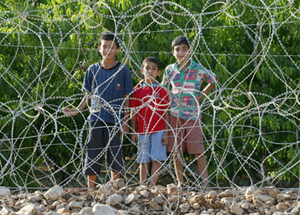|
COMMENTARYRhetoric, Reality and
|
 |
|
Near Qalqilya, this barbed wire forms part of a 200-foot-wide Wall that Israel is building around the whole West Bank. The Wall enables Israel to annex much of the Palestinian's best land and water supply. |
Has U.S. policy towards the Israeli occupation of Palestinian lands changed since the Iraq war and occupation?
Certainly President George Bush is engaged in this conflict in a way he has not been before. He put his weight behind a "road map" for peace, meeting with Israeli Prime Minister Ariel Sharon and Palestinian Prime Minister Mahmoud Abbas at the June 4 Aqaba summit. He has also sent high-level diplomats on repeated visits to the region.
But Bush's newfound peace rhetoric belies the reality on the ground. Israel is building a Wall inside the West Bank that is 360 kilometers long and between eight and 30-feet high--three times as long and twice as high as the Berlin Wall. Construction of the Wall is destroying some of the best agricultural land and trapping thousands of Palestinians in a closed Israeli military zone.
The Wall is effectively annexing more Palestinian land to Israel. When complete, less than 50 percent of the West Bank will remain for the so-called Palestinian state, according to calculations by the Israeli peace bloc Gush Shalom (www.gush-shalom.org).
Qalqilya is one of the Palestinian towns being carved up by the Wall. The residents sent an urgent appeal to the Aqaba summit "from the hearts of thousands of children, women and elders whose trees are being uprooted, whose lands are being razed, whose elders and children are being beaten daily…There is no place for peace with this Apartheid Wall, no peace with settlements and settlers who steal our land and threaten our future…Thousands of families have lost their main income and source of livelihood due to the building of the Wall."
The massive gap between rhetoric and reality is just one thing wrong with the road map. There's more:
The Bush administration is not changing the policies that sustain Israel's occupation. The U.S. continues to subsidize Israel with $3 billion per year in aid, plus billions more in loan guarantees. It also supplies weapons that Israel often uses for offensive purposes, a violation of the U.S. Arms Export Control Act that limits their use to self-defense. And the U.S. uses its veto at the U.N. to prevent the formation of an international force to protect Palestinians and Israeli civilians until the occupation ends.
In short, while the language of U.S. policy towards Israel's occupation has changed, the substance has not. Until it does people are joining organizations like the International Solidarity Movement (www.palsolidarity.org), which sends international civilians to try to protect the Palestinians, and the US Campaign to End the Israeli Occupation www.endtheoccupation.org, which seeks U.S. policies that apply international law to one of the longest and most brutal military occupations the world has known.
Nadia Hijab, a writer on the Middle East and a human rights advocate, co-chairs the US Campaign to End the Israeli Occupation.
| Month in Review |
|---|
|
August 2010: |
| PAST articles |
Detoit: I Do Mind Empire (USSF Recap) “Bring the War (English) Time for Rebirth: (English) War Weariness, Military Heft, and (English) The Global Military Industrial Complex (English) A Stalled (English) Bush's Iraq “Surge”: Mission Accomplished? Iran: Let's Start with Some Facts Nuclear Weapons Forever (English) Time to End the Occupation of Iraq First-Hand Report from the Middle East (English) Haditha is Arabic (English) A Movement to End Militarism From Soldier to Students Not Soldiers Israel's "Disengagement" U.S. Soldiers Torture: Help Stop Torture — Be All You Can Be: OCTOBER 2006
|
|
War Times/Tiempo de Guerras is a fiscally sponsored project of the |